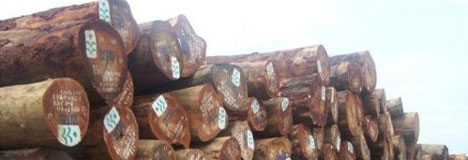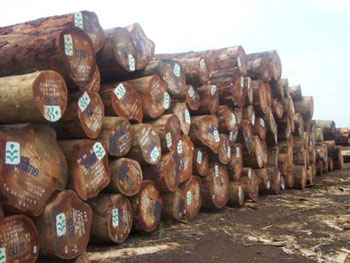Boosted as always by exportations of raw materials including forestry products, hydrocarbons, cocoa, coffee, cotton and rubber, the Cameroonian economy realised in 2001 a growth of 4.1 percent of the GDP, a sign of a marked progression of the recovery started in 2010, official figures have revealed.

Boosted as always by exportations of raw materials including forestry products, hydrocarbons, cocoa, coffee, cotton and rubber, the Cameroonian economy realised in 2001 a growth of 4.1 percent of the GDP, a sign of a marked progression of the recovery started in 2010, official figures have revealed.

Even though this rate is below the average of 5.2 percent within the Central African Economic and Monetary Community (CEMAC) grouping Cameroon, Congo, Gabon, Equatorial Guinea, Central African Republic and Chad, it is beyond the initial projection of 3.8 percent and confirms the upward trend stirred by the recovery of 3.3 percent of 2010, following the counter-performance of 1.9 percent of 2009 in the waked of the global economic crisis.
When presenting the Government's economic, financial, social and cultural programme for the year 2012 to the members of parliament in mid-November, Prime Minister Philemon Yang declared "this upward growth was mainly sustained by silvicultural production that has recorded a rise of 10 percent, and the production of cash crops where a rise of 7 percent has been recorded."
In the secondary sector, the growth rate stands at 1.4 percent, against 0.5 percent in 2010.
Authorities justify these results by the actions carried out as part of job and wealth creation efforts. For example, "the vaccine coverage has made it possible to reduce the mortality rate of village poultry farming by 20 percent. Meat and milk productions have followed a marked rise, by 15,000 tonnes and 50,000 litres respectively, thanks to the support and assistance granted to the different groups of livestock breeders and thanks to the vaccination of about 1,300,000 poultries.
This support, they said, made it possible to put in the market 427 tonnes of milk products during the finishing year also marked by the pursued execution of a funding of 4.5 billion CFA ($9 million) since 2005 for the development of the pig breeding sector, where about 30,000 breeders have declared benefitting directly or indirectly from specific assistance measures.
Boosted by an upturn of the international market, the marketing of the cash crops has improved, notably thanks to the construction of 9 storage sheds for cocoa and coffee, and the diffusion of the purchase price that guarantees a fair remuneration for producers.
As a top export product after oil, raw cocoa in beans has regained momentum to stand at 218,702 tonnes in 2010-2011, hence generating 301.410 billion CFA ($602.820 million) of revenue for the Government in 2010, for 193,881 tonnes of exports, while the production was following a downward turn, standing at 195,000 tonnes at the end of the campaign 2009-2010 after reaching 210,000 tonnes during the previous campaign,
For its part, coffee, which has now been relegated to the 5th position of export products after taking the top position a few years ago, and standing at 22nd position at global ranking with a production estimated between 35,000 and 40,000 tonnes/year, after occupying the 12th position some fifteen years ago, concentrated its conquest to market niches which, thanks to washed coffee, has prompted a rise in the sales price of 25-41 percent, according to the Inter-professional Cocoa and Coffee Council (CICC).
However, the upturn of the GDP growth was marred by the rise in the inflation rate to 3 percent, insofar as the uncontrolled hike of 5.3 percent recorded in 2008, a year marked by a surge of violence against the high cost of living, had been put down to 1.3 percent in 2010 after plummeting to 3 percent in 2009.
The organising of promotional staple sales campaigns by public authorities to in a bid to fight against the high cost of living, commercial speculations and other anti-competitive practices had little effect in protecting households from the distress of their dwindling purchasing power.
However, these households kept securing subsidized fuel prices that cost the Public Treasury some 315 billion CFA ($630 million) all year long, out of an amount of 700 billion CFA ($1.4 billion) engaged since 2007, an investment eventually deemed so heavy to help the Government further its social welfare policy and give impetus to national economic development at the same time.
With 7 million of poor people and a monetary poverty rate of 39.9 percent for a population that officially reached the bar of 20 million inhabitants in 2011, with a growth of 2.8 percent/year, Cameroon targets, through the Growth and Employment Strategy Paper (DSCE) adopted by the Government in 2009, the objective of an average annual growth of 5.5 percent of the GDP over the period 2010-2020.
The success of its first bond liability of 200 billion CFA ($400 million) in November 2010 gave public authorities a solid argument to undertake with more confidence, the unprecedented emission of treasury bills to the tune of 50 billion CFA ($100 million) as from mid-November for the funding of the national economy, and promote the local and regional financial market.
These funds are invested in the implementation of projects that touch on the launching, in late February, of a new national airline (Camair – Co), the construction of infrastructure such as the deep-sea port of Kribi (South), the foundation stone of which was laid in early October by the President Paul Biya himself, for an amount of 240 billion CFA ($480 million) including 207.7 billion CFA earmarked in the form of a preferential rate credit provided by Exim-Bank of China
Another project upon Chinese funding and concerning the construction of the hydroelectric dam of Memve'ele (South) evaluated at 243 billion CFA ($486 million) has also started; with at stake an installed power of 201 MW and a yearly production of 1,140 GW. A similar project is also underway in Lom Pangar (East) and is financed thanks to French and African funding, but implemented by a Chinese enterprise, China International Water&Electric Corp. (CWE).
Currently, this electrical production is established at 1,022 MW, pending the injection of additional 100 MW by the end of this year thanks to an emergency thermal programme worth 60 billion CFA ($120 million).
Apart from the installation of over 5,000 km of optic fibre, including 3,200 km upon Chinese funding, an infrastructure very likely to improve the quality of telecommunication services, 2011 was also the occasion to launch the construction in Douala, the economic capital, of the first cement plan in Cameroon belonging to the Nigerian tycoon Aliko Dangote.
Flattered by the results obtained, Yaounde authorities have endowed the Government with a budget of 2,800 billion CFA ($5.6 billion) for 2012, against 2,571 billion CFA ($5.142 billion) in 2011, for a project GDP growth of 5.5 percent.
Raphaël MVOGO and LIU Fang